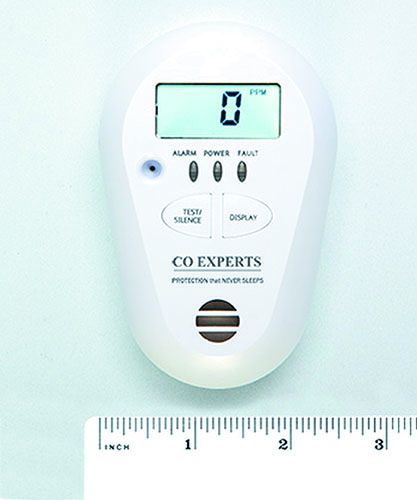Last December, the National Transportation Safety Board (NTSB) created a stir by publishing a recommendation calling for the FAA to require that all enclosed-cabin piston-engine aircraft be equipped with a low-level carbon monoxide (CO) detector and that aviation alphabet organizations inform their members about the dangers of CO poisoning, encourage them to install CO detectors and ensure thorough exhaust system inspections.
Some aviators read the headlines and reacted as if the NTSB were mandating the demise of general aviation. The details and background of the NTSB’s recommendation are in the sidebar on the next page and we’ll point out right here that the NTSB does not have the power to compel the FAA to do anything.
When it comes to the potential for a requirement to install another device in your airplane, we recommend following the explicit advice given by Douglas Adams in his novel The Hitchhiker’s Guide to the Galaxy: Don’t panic. New regulations do not come about quickly and if the FAA does propose to issue regulations, all of us will have an opportunity to comment and push back on something we don’t like.
In the meantime, we believe that we should focus on the underlying message—CO poisoning, while rare, is a real risk and pilots should act to protect themselves from it.
We’ll say it up front: Because sensitive portable CO detectors are not terribly expensive—and we’ve been using them for years—we recommend pilots use them on every flight.
We’ll explain the reasons for our recommendation and tell you about the CO detectors we reviewed, which we think are best and why.
IT’S A MALEVOLENT GAS
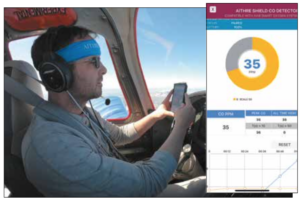
When we burn avgas or mogas in our bugsmashers carbon monoxide results because of incomplete combustion of the fuel. The richer the mixture, the more CO results. As an aside, one of the many benefits of operating lean of peak EGT is more complete combustion of the fuel and greatly reduced CO emission.
Should the CO get into the cabin—usually because of an exhaust leak—and we inhale it, bad things start to happen quickly. When we breathe, incoming oxygen reaches the lungs and combines with the hemoglobin in our red blood cells to form oxyhemoglobin. Our arteries transport the oxyhemoglobin into the capillaries where it oxygenates the cells of our tissues and organs. The deoxygenated hemoglobin returns via the veins to the lungs to reoxygenate for another round trip.
Compared to oxygen, CO has super-powers in the worst way possible. It combines with our hemoglobin to form carboxyhemoglobin (COHb) with a bond that is 200 times stronger than oxygen’s bond with hemoglobin.
OXYGEN DEPRIVATION
When CO moves into our bodies it effectively disables the hemoglobin, depriving the body of oxygen. The power of the COHb bond means that tiny concentrations of CO can kill us through poisoning over a few hours—the length of a routine general aviation flight. Even if doesn’t kill you directly, it can so disrupt your ability to function that you are unable to control the airplane.
To add to the unpleasant news, because the COHb bond is so strong, it takes several hours to purge CO from our bodies. COHb has a half-life of five hours for a person breathing normal air. So, if our COHb saturation is 50 percent, it won’t be down to 25 percent—which still negatively affects one’s ability to function—for five hours. A poisoned pilot may have managed to land, feeling lousy and wondering why, and an hour or so later be unable to handle the rain-slick curve on the drive home.
There’s more—if a person realizes what’s going on and goes on pure oxygen, the half-life of the COHb bond is still two hours. If an affected person is stuffed into a hyperbaric chamber with pure oxygen at three atmospheres, the half-life of COHb can be cut to a half-hour.
HIGHER FUNCTIONS
Because CO’s MO is oxygen deprivation of the body, it’s especially ugly because it starts taking out the important parts of the body right away: brain, nervous system, heart and lungs—the parts necessary for higher functioning so that we can do the pilot stuff we do.
Of course there are symptoms—headache, fatigue, dizziness, vision problems, increased pulse and respiration rates and nausea—but they are not exclusive to CO poisoning. The fact that CO poisoning immediately affects higher brain functions means that there’s a good chance the pilot will not recognize what’s going on.
Yes, there’s more bad news—this is aviation after all. The normal hypoxia we pilots experience as altitude increases exacerbates the effects of even low CO concentrations in the bloodstream. For example, a 10 percent COHb concentration on the ground is not a big deal—it’s normal for a smoker. However, once at 10,000 feet with hypoxia kicked in, it means that night vision and judgment are significantly impaired.
For pilots who use a pulse oximeter to track hypoxia, those units do not detect CO in the blood.
THE NUMBERS
Based on our review of aeromedical data, it is our opinion that if a CO detector shows an inflight CO concentration of 10 parts per million (PPM), the pilot/owner should take action to find and eliminate the source. If it gets to 35 PPM we recommend landing as soon as practical—and using oxygen if it is available while doing so.
The above causes us to recommend that a pilot use a CO detector that has a digital readout that starts no higher than 10 PPM and has an aural alarm at no higher than 35 PPM.
The OSHA standard for allowable CO in a workplace is 50 PPM, which is the point at which many CO detectors alarm. In our opinion, because of the risk presented by low levels of CO in an aircraft, we think that is too high.
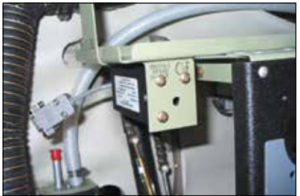
All of the panel-mounted CO detectors we surveyed only alarmed once the CO level reached 50 PPM. Some also had a delay before the alarm sounded. In our opinion that is not satisfactory.
LOCATION, LOCATION
We made flights in which we detected CO in the cabin and used a portable CO detector to scope out the intensity. Not surprisingly, the level varied in different areas of the cabin. In our flights we did not get any CO from the heater vents (the exhaust systems were in good shape; it was in the aft cabin). In conversations with aeronautical engineers at some aircraft manufacturers, we learned that the airflow in the rear fuselage is back to front and sometimes pulls in exhaust gases going under the aircraft. If the baggage curtain does not seal well, the CO will come into the cabin. That’s significant news—the risk is not limited to leaking exhaust systems.
A panel-mounted unit might not detect an aft-cabin leak until it becomes serious enough to reach the sensor. We like the ability to move a detector around to check on levels and identify the source of a leak.
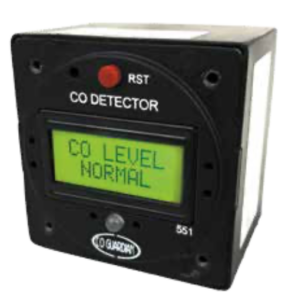
We obtained and tested a random sampling of the detectors on the market—we’ll identify each one below. Each worked as it was claimed to—alerting at the level it said it would.
We think that a portable unit should designed to be capable of being placed where the pilot can easily see the digital readout during routine panel scans.
We think the CO Experts units are the best of the portables with the Aithre Shield a close second. We also recommend the other portable electronic units because we consider the initial alarm threshold to be satisfactory and they have digital displays. The list below, after CO Experts and Aithre, is in no particular order. We address the chemical spot type units last and do not recommend them at all because of the shortcomings we outline.
CO EXPERTS
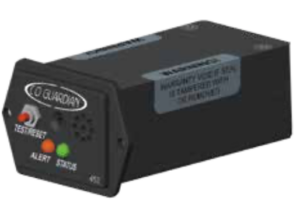
CO Experts (www.coexperts.ca) makes what we consider to be the top-of-the-line portable CO detectors. We obtained and tested its Model 2016-10 Low Level CO Health Monitor ($189.95). We did not test its slightly more sophisticated brother, the Model PG-2017 Ultra Low Level CO Health Monitor, or the Model 2016-25, which is identical to the -10 but has a higher initial alert level.
The Model 2016-10 has a 85-dB Piezo alarm that can be heard when wearing a noise-canceling headset. We like the fact that it displays CO starting at 7 PPM and makes its first alert at 10 PPM audibly and with a red light. The audible alarms are graduated and alert more frequently as CO concentration increases. The alarms can be silenced, but the red light remains on.
The 2016-10 has a low-battery alert, and alarm memory and recall to display exposure history. We were impressed by the fact that it also has an approximate COHb level for someone who has been exposed to CO as recorded by the unit, of value for an inflight exposure event to help determine if there is a need for treatment and to provide information for medical personnel. Expected life is five years.
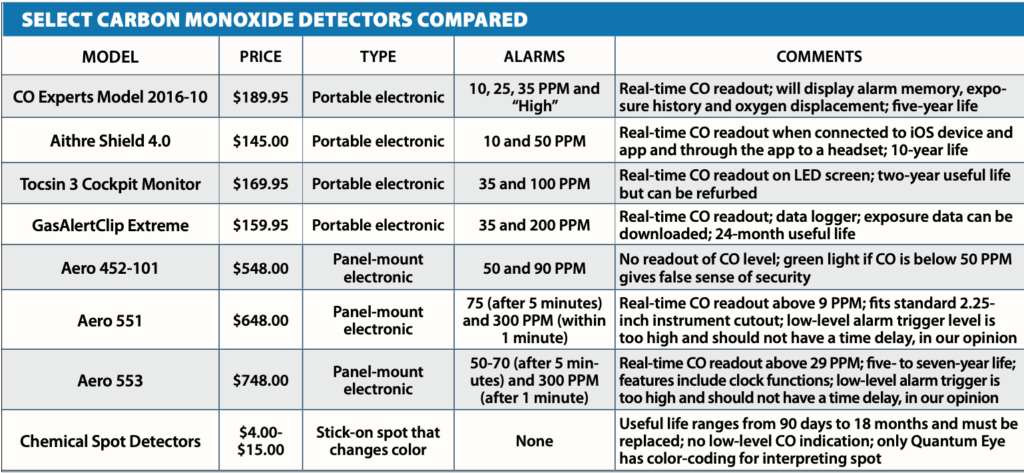
AITHRE SHIELD
Offered for $145.00 through mypilotstore (www.mypilotstore.com), the Aithre Shield 4.0 Portable CO Detector unit not only gives visual and aural alerts (the detector itself gives no aural alert; it has to be connected to the app, a shortcoming, in our opinion), but it connects to an iOS device and to Bluetooth-capable headsets. It alerts with a flashing yellow light at 10 PPM and aurally and with a red light at 50 PPM. Its digital readout reads between 0 and 255 PPM.
The Aithre Connect App (an impressive interface) provides 15-minute data trend history. When connected with a headset, Siri gives notifications when the 10- and 50- PPM levels are reached—stating that carbon monoxide is present and the level observed.
Even when not connected to the app, the unit provides real-time CO information by pulsing a blue light when all is well. Other portable units we surveyed had an expected life of two to five years; the Shield instead uses a rechargeable battery and will last 10 years without needing recalibration. The charging unit has a clip so it can double as a mount so the unit does not have to be periodically removed from the airplane.
TOCSIN
Available through Sporty’s (www.sportys.com) for $169.95, the Tocsin 3 CO Cockpit Monitor (it may also be listed as the Tocsin OI-315) is designed for aircraft use with a piercing 90-dB alarm. It has a belt clip (think CFIs who rotate between aircraft), mounting ring and hook and loop tape so it can be mounted just about anywhere. This is another unit that we tested—we found the mounting options handy.
It initially alarms at 35 PPM, with no delay on the alarm. The first alarm can be silenced. At 100 PPM the high-level alarm sounds and cannot be silenced unless the unit is moved to a fresh air location and then shut off. We think that is a distraction.
GAS ALERT CLIP
Aircraft Spruce (www.aircraftspruce.com) asserts that the GasAlertClip Extreme is the world’s most popular, zero-maintenance CO detector. At $159.95 the unit has a two-year life, not great, in our opinion, for the price. The upside is that it is designed for rugged environments with a “concussion-proof housing” (let’s give it to a three-year-old and find out) and has both a belt clip and loop that allow it to be hung almost anywhere.
Another factor in the design, according to the manufacturer, is that the target customers are workers in facilities where there is a risk of CO exposure and who need a unit that requires minimal training and simple operation. That sounds to us like the interior of a general aviation airplane.
The digital readout sensor has a range from 0 to 300 PPM. The low-level alarm is set at 35 PPM and triggers a 95-dB tone, and flashing LED light and vibrates the case. A data logger records exposures—which can be downloaded.
PANEL MOUNTS
We’re partial to portable CO units but they certainly aren’t perfect and there is always the risk of losing it or simply forgetting to turn it on prior to flight—making panel-mounted units that come alive when the avionics master switch is turned on attractive. However, we were not impressed by the capabilities of any of the units we surveyed.
Guardian Avionics (www.guardianavionics.com) is the major player in the panel-mount world, making five detectors for the panel and two remote-mount devices. They differ in size and features, with one that includes a pulse oximeter—although it was out of stock at the time this article was prepared. We surveyed three of the Guardians.
The Aero 452-101 fits into a 2.25 by 1.5 inch panel opening and weighs just 3.5 ounces. It is priced at $548 and usually requires two hours to install. It provides CO detection and a cabin pressure warning. It does not have a display on the unit itself, but will communicate with a number of PFDs, MFDs and engine monitors.
The unit detector operates on either 14 or 28 volts and has an internal fan to improve its sensing ability. We are not crazy about the alerting provided—at anything below 50 PPM, a green light shines continuously. The CO level has to reach 50 PPM and remain there for three to five minutes before it sounds an 85-dB tone and flashes an amber light. At 90 PPM it alarms immediately and flashes a red light.
At $648, the Aero 551 CO detector is Guardian’s most sophisticated The upside is that it has a digital display of CO from 10 to 999 PPM and fits in a standard 2.25-inch round instrument cutout. The downside is that the first alarm doesn’t happen until the CO level reaches 75 PPM and stays there for five minutes. If it gets to 300 PPM it still doesn’t alarm immediately; it can delay as long as a minute.
The Aero 553 is designed to replace the panel clock—it has a clock function—and otherwise matches the functionality of the 551. At $748, it also has a flight timer, stopwatch, inside and outside air temperature, battery voltage, cabin altitude and density altitude. Remote Guardian detectors can display on PFDs, including Dynon’s HDX. Life span of the units is five to seven years.
SPOT DETECTORS
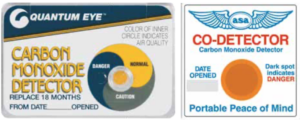
The more we learn about chemical spot CO detectors the more we solidly believe that they are worthless and may actually give a false sense of security to a pilot.
They consist of a piece of cardboard or plastic that contains a chemical patch that is to turn dark in the presence of CO. They are marketed under various names and we’ve seen prices from $4 to $15.
Some have instructions on the back showing the shade of “dark” for various levels of CO; however, it’s tough to read them when the unit is stuck to the instrument panel—where most of them reside.
On the good side, the Quantum Eye unit has the colors on the face of the unit, next to the spot.
The life cycle for the spot detectors ranges from 90 days to 18 months. Our experience is that tightwad pilots put them on the panel and leave them forever. We have only rarely seen one with the date it was mounted written on the face of the detector. We’ve never seen one with the date for it to be replaced written on it.
We tested a spot detector and found that it turned dark at 90 PPM—a level we consider far too high for an initial alarm. There is no aural alarm—the pilot must observe the spot and decide if it has changed color. We do not have information as to whether that is more difficult under night flight deck lighting—or even possible.
We observed a demonstration by a manufacturer of an electronic detector in which a spot detector was placed in a test cell with 20 PPM of CO, a level we consider to be potentially hazardous in flight. The spot did not change color. Accordingly, it is our opinion that it can lull a pilot into a false sense of confidence, not a good thing when one of the symptoms of CO poisoning is decreased ability to make good decisions.
The best of the bunch of spot detectors is the Quantum Eye because of its presentation of color coding and clear instructions about replacement. In the past we have said that spot detectors are better than no detector. We are no longer of that opinion.
RESIDENTIAL DETECTORS
We cannot recommend any residential CO detector as they generally follow Underwriters Laboratories spec UL-2034 that requires a time delay before the unit will alarm. The purpose is to reduce 911 calls for false alarms. We were astonished to learn that the delay time for 70 PPM is four hours and at 400 PPM, it’s 15 minutes. In addition, if there is a digital display it is may not show CO levels below 30 PPM.
CONCLUSION
We recommend that pilots purchase and use an electronic CO detector with a digital display that begins no higher than 10 PPM and has an initial alarm at no higher than 35 PPM.
We’re going to be watching to see what the FAA does in response to the NTSB’s recommendations on CO detectors—and if the FAA issues proposed rule making we will suggest that should the FAA issue a regulation that an aviation-appropriate CO detector can be portable and meets the above display and alarm recommendations.
CO exposure to pilots is rare, but when it happens it can be a deadly serious event. Being armed with a good portable electronic CO detector may downgrade the event to merely unpleasant.

